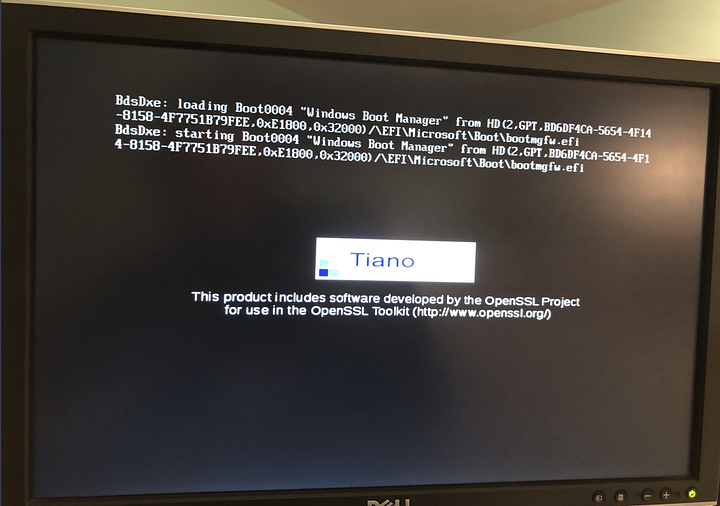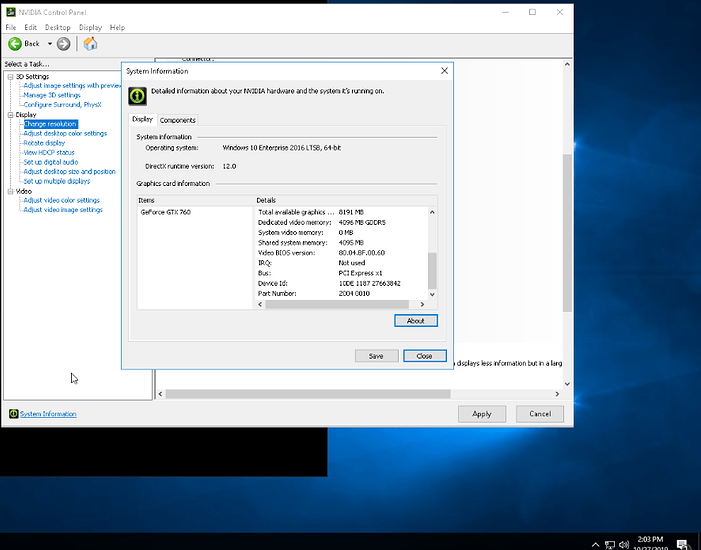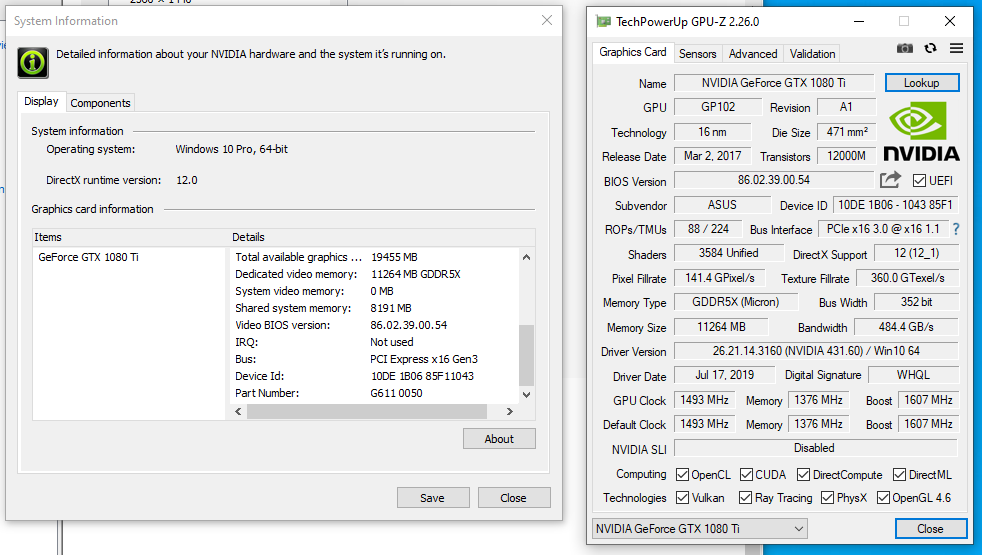chase9
August 1, 2019, 4:45pm
41
I have another tip about using looking glass on Fedora.
The Arch Wiki has a good guide on getting looking glass setup on your machine, especially using systemd-tmpfiles to automatically create looking glass’s shared memory file. However, upon rebooting you’ll likely get an error when trying to start your VM saying permission to /dev/shm/looking-glass was denied.
This is due to SELinux on Fedora, which doesn’t think that QEMU should have access to files with memory mappings. On my machine I was able to give QEMU the proper permissions by running three commands:sudo ausearch -c 'qemu-system-x86' --raw | audit2allow -M my-qemusystemx86sudo semodule -X 300 -i my-qemusystemx86.ppsudo setsebool -P domain_can_mmap_files 1
The first command finds SELinux errors relating to the qemu system and pipes them to audit2allow, which generates necessary SELinux policies into a file named “my-qemusystemx86.pp”.
The second command will install the policies in my-qemusystemx86.pp with a priority of 300.
The third command sets an SELinux policy to true, but I was unable to find documentation on domain_can_nmap_files. If anyone knows the consequences of setting this to true, let me know!
4 Likes
Hey what does: vm.hugelb_shm_group mean? Is it the group that has access to the hugepages? If yes why is it set to 48? At least on my system it relates to apache XD Shouldn’t it therefore be 107 for qemu or 36 for kvm?
[modzilla@fedora-server ~]$ id 48
uid=48(apache) gid=48(apache) groups=48(apache)
[modzilla@fedora-server ~]$ id qemu
uid=107(qemu) gid=107(qemu) groups=107(qemu),36(kvm)
EDIT: Yeah I’m using 107 now and that seems to work ok!
2 Likes
Thank you for posting this and these links! Very helpful.
1 Like
So the 1st part of your post, about the initramfs/dracut was helpful. However, I could get the script on the initramfs but it would not execute. I know this because driver_override would be (null) in /sys/bus/pci/devices/$DEV/driver_override. (For my case, $DEV was 0000:01:00.0 and 0000:01:00.1
So I went through the dracut docs and created a module for vfio:
cd /usr/lib/dracut/modules.d
mkdir -p 11vfio
cd 11vfio
I created the file modules.setup.sh with the contents:
#!/usr/bin/bash
check() {
return 0
}
depends() {
return 0
}
install() {
inst_hook pre-pivot 00 "$moddir/vfio-pci-override.sh"
}
and copied the vfio-pci-override.sh script you provided above.
I did another:
sudo dracut -fv
so, now driver_override in the /sys directory tree shows vfio-pci, however, it does not say kernel driver is in use on lspci -vnn output for my NVidia card. hrm.
1 Like
Appreciated all the helpful messages. Tomorrow I shall have some time and update the guide after testing them on the Fedora 30 machine.
1 Like
I have problem with both procedures to override the PCI driver.
Looks like the module is correctly installed:dmesg | grep vfio:
[ 1.328582] vfio_pci: add [10de:13c2[ffffffff:ffffffff]] class 0x000000/00000000
But later on NVIdia driver is still loaded and override is replaced.
Overrides are missing
gnif
September 13, 2019, 10:06am
47
Does lspci -v show the module in use for the device is vfio-pci?
lor3
September 17, 2019, 10:33pm
48
Got this working thanks to these instructions, first it’s module.setup.sh not module**s**.setup.sh - this had me for ages.
Secondly I used the pre-udev dracut hook rather than pre-pivot.
Lastly I added rd.driver.pre=vfio-pci to grub cmdline.
All working, many thanks to everyone in this thread!
2 Likes
Hi,
I was finally able to patch the kernel and get vfio working. But when I boot a Windows 10 install, the second monitor that just displays the below image and never goes any further. Does anyone have any idea as to how I can go about figuring this out?
1 Like
chase9
October 27, 2019, 1:06pm
50
That image is the UEFI initializing, so it’s hard to say any one problem you’re running into. The first two things I’d check is that your VM is set to use Q35 and UEFI, and that you’ve passed through the entire GPU (including possibly the usb controller or audio, if your GPU has one).
My first guess is that your windows is either not installed or fails to load.
Thanks @chase9 and @BansheeHero !
I tried a bunch of things and it looks like passing through a USB mouse and KEYBOARD got it to work. I now have my GeForce 760 passed through to a Windows 10 VM and looking-glass is working.
However , why would the nVIDIA control panel system settings in the Windows VM output “Pci Express x1”? Should it not be x8 on a ASRock Taichi Ultimate with 3 slots filled (x8, x8, x4)?
kbdeamon:
However , why would the nVIDIA control panel system settings in the Windows VM output “Pci Express x1”? Should it not be x8 on a ASRock Taichi Ultimate with 3 slots filled (x8, x8, x4)?
That tends to be due to the PCIe setup in the VM. Since QEMU emulates the entire PCI tree, it has to emulate a slot with X amount of lanes. It may be incorrectly configured. I normally don’t have this problem. Could you post a current XML so I can take a gander?
1 Like
thro
October 27, 2019, 11:56pm
54
Will try to run through this some time.
Have fedora, 2x Vega 64s and an RX480 so i can potentially test both same gpu and different GPUs at least on the AMD side.
I have been slacking on this thread so any updates are welcomed.
At the moment I am playing the Outer Worlds and huge pages helped a lot. I also have a CPU problem that got over 30% better just by enabling them and then pinning the CPU.
Have some notes on how to set it up.
chase9
October 29, 2019, 1:57pm
56
I hadn’t noticed this, but after seeing @kbdeamon post I thought I’d check mine. I’m also emulating PCIe x1. FWIW here’s my config:
Summary
<domain type="kvm">
<name>win10</name>
<uuid>305e53f1-49be-4d1d-82ae-c630f88af39f</uuid>
<metadata>
<libosinfo:libosinfo xmlns:libosinfo="http://libosinfo.org/xmlns/libvirt/domain/1.0">
<libosinfo:os id="http://microsoft.com/win/10"/>
</libosinfo:libosinfo>
</metadata>
<memory unit="KiB">8388608</memory>
<currentMemory unit="KiB">8388608</currentMemory>
<memoryBacking>
<hugepages/>
</memoryBacking>
<vcpu placement="static">8</vcpu>
<iothreads>1</iothreads>
<cputune>
<vcpupin vcpu="0" cpuset="1"/>
<vcpupin vcpu="1" cpuset="9"/>
<vcpupin vcpu="2" cpuset="2"/>
<vcpupin vcpu="3" cpuset="10"/>
<vcpupin vcpu="4" cpuset="3"/>
<vcpupin vcpu="5" cpuset="11"/>
<vcpupin vcpu="6" cpuset="4"/>
<vcpupin vcpu="7" cpuset="12"/>
<emulatorpin cpuset="0-1"/>
<iothreadpin iothread="1" cpuset="0-1"/>
</cputune>
<os>
<type arch="x86_64" machine="pc-q35-3.1">hvm</type>
<loader readonly="yes" type="pflash">/usr/share/edk2.git/ovmf-x64/OVMF_CODE-pure-efi.fd</loader>
<nvram>/var/lib/libvirt/qemu/nvram/win10_VARS.fd</nvram>
<boot dev="hd"/>
<bootmenu enable="no"/>
</os>
<features>
<acpi/>
<apic/>
<hyperv>
<relaxed state="on"/>
<vapic state="on"/>
<spinlocks state="on" retries="8191"/>
<vpindex state="on"/>
<runtime state="on"/>
<synic state="on"/>
<stimer state="on"/>
<reset state="on"/>
<vendor_id state="on" value="1234567890ab"/>
<frequencies state="on"/>
<reenlightenment state="on"/>
<tlbflush state="on"/>
<ipi state="off"/>
<evmcs state="off"/>
</hyperv>
<kvm>
<hidden state="on"/>
</kvm>
<vmport state="off"/>
</features>
<cpu mode="host-passthrough" check="none">
<topology sockets="1" cores="4" threads="2"/>
<feature policy="require" name="topoext"/>
</cpu>
<clock offset="localtime">
<timer name="rtc" tickpolicy="catchup"/>
<timer name="pit" tickpolicy="delay"/>
<timer name="hpet" present="no"/>
<timer name="hypervclock" present="yes"/>
</clock>
<on_poweroff>destroy</on_poweroff>
<on_reboot>restart</on_reboot>
<on_crash>destroy</on_crash>
<pm>
<suspend-to-mem enabled="no"/>
<suspend-to-disk enabled="no"/>
</pm>
<devices>
<emulator>/usr/bin/qemu-system-x86_64</emulator>
<disk type="block" device="disk">
<driver name="qemu" type="raw" cache="none" io="native"/>
<source dev="/dev/disk/by-id/nvme-PCIe_SSD_19060410240257"/>
<target dev="sda" bus="scsi"/>
<address type="drive" controller="0" bus="0" target="0" unit="0"/>
</disk>
<controller type="usb" index="0" model="qemu-xhci" ports="15">
<address type="pci" domain="0x0000" bus="0x03" slot="0x00" function="0x0"/>
</controller>
<controller type="sata" index="0">
<address type="pci" domain="0x0000" bus="0x00" slot="0x1f" function="0x2"/>
</controller>
<controller type="pci" index="0" model="pcie-root"/>
<controller type="pci" index="1" model="pcie-root-port">
<model name="pcie-root-port"/>
<target chassis="1" port="0x10"/>
<address type="pci" domain="0x0000" bus="0x00" slot="0x02" function="0x0" multifunction="on"/>
</controller>
<controller type="pci" index="2" model="pcie-root-port">
<model name="pcie-root-port"/>
<target chassis="2" port="0x11"/>
<address type="pci" domain="0x0000" bus="0x00" slot="0x02" function="0x1"/>
</controller>
<controller type="pci" index="3" model="pcie-root-port">
<model name="pcie-root-port"/>
<target chassis="3" port="0x12"/>
<address type="pci" domain="0x0000" bus="0x00" slot="0x02" function="0x2"/>
</controller>
<controller type="pci" index="4" model="pcie-to-pci-bridge">
<model name="pcie-pci-bridge"/>
<address type="pci" domain="0x0000" bus="0x01" slot="0x00" function="0x0"/>
</controller>
<controller type="pci" index="5" model="pcie-root-port">
<model name="pcie-root-port"/>
<target chassis="5" port="0x13"/>
<address type="pci" domain="0x0000" bus="0x00" slot="0x02" function="0x3"/>
</controller>
<controller type="pci" index="6" model="pcie-root-port">
<model name="pcie-root-port"/>
<target chassis="6" port="0x14"/>
<address type="pci" domain="0x0000" bus="0x00" slot="0x02" function="0x4"/>
</controller>
<controller type="pci" index="7" model="pcie-root-port">
<model name="pcie-root-port"/>
<target chassis="7" port="0x15"/>
<address type="pci" domain="0x0000" bus="0x00" slot="0x02" function="0x5"/>
</controller>
<controller type="pci" index="8" model="pcie-root-port">
<model name="pcie-root-port"/>
<target chassis="8" port="0x16"/>
<address type="pci" domain="0x0000" bus="0x00" slot="0x02" function="0x6"/>
</controller>
<controller type="pci" index="9" model="pcie-root-port">
<model name="pcie-root-port"/>
<target chassis="9" port="0x17"/>
<address type="pci" domain="0x0000" bus="0x00" slot="0x02" function="0x7"/>
</controller>
<controller type="scsi" index="0" model="virtio-scsi">
<driver queues="8"/>
<address type="pci" domain="0x0000" bus="0x09" slot="0x00" function="0x0"/>
</controller>
<controller type="virtio-serial" index="0">
<address type="pci" domain="0x0000" bus="0x06" slot="0x00" function="0x0"/>
</controller>
<interface type="direct">
<mac address="52:54:00:76:6c:d5"/>
<source dev="enp4s0" mode="bridge"/>
<model type="virtio"/>
<address type="pci" domain="0x0000" bus="0x02" slot="0x00" function="0x0"/>
</interface>
<serial type="pty">
<target type="isa-serial" port="0">
<model name="isa-serial"/>
</target>
</serial>
<console type="pty">
<target type="serial" port="0"/>
</console>
<channel type="unix">
<target type="virtio" name="org.qemu.guest_agent.0"/>
<address type="virtio-serial" controller="0" bus="0" port="1"/>
</channel>
<input type="mouse" bus="ps2"/>
<input type="keyboard" bus="ps2"/>
<video>
<model type="virtio" heads="1" primary="yes">
<acceleration accel3d="yes"/>
</model>
<address type="pci" domain="0x0000" bus="0x00" slot="0x01" function="0x0"/>
</video>
<hostdev mode="subsystem" type="pci" managed="yes">
<source>
<address domain="0x0000" bus="0x0a" slot="0x00" function="0x0"/>
</source>
<address type="pci" domain="0x0000" bus="0x04" slot="0x01" function="0x0"/>
</hostdev>
<hostdev mode="subsystem" type="pci" managed="yes">
<source>
<address domain="0x0000" bus="0x0a" slot="0x00" function="0x1"/>
</source>
<address type="pci" domain="0x0000" bus="0x04" slot="0x02" function="0x0"/>
</hostdev>
<hostdev mode="subsystem" type="pci" managed="yes">
<source>
<address domain="0x0000" bus="0x0a" slot="0x00" function="0x2"/>
</source>
<address type="pci" domain="0x0000" bus="0x04" slot="0x03" function="0x0"/>
</hostdev>
<hostdev mode="subsystem" type="pci" managed="yes">
<source>
<address domain="0x0000" bus="0x0a" slot="0x00" function="0x3"/>
</source>
<address type="pci" domain="0x0000" bus="0x04" slot="0x04" function="0x0"/>
</hostdev>
<hostdev mode="subsystem" type="pci" managed="yes">
<source>
<address domain="0x0000" bus="0x0c" slot="0x00" function="0x3"/>
</source>
<address type="pci" domain="0x0000" bus="0x07" slot="0x00" function="0x0"/>
</hostdev>
<redirdev bus="usb" type="spicevmc">
<address type="usb" bus="0" port="2"/>
</redirdev>
<redirdev bus="usb" type="spicevmc">
<address type="usb" bus="0" port="3"/>
</redirdev>
<memballoon model="virtio">
<address type="pci" domain="0x0000" bus="0x05" slot="0x00" function="0x0"/>
</memballoon>
<shmem name="looking-glass">
<model type="ivshmem-plain"/>
<size unit="M">32</size>
<address type="pci" domain="0x0000" bus="0x04" slot="0x05" function="0x0"/>
</shmem>
<shmem name="scream-ivshmem">
<model type="ivshmem-plain"/>
<size unit="M">2</size>
<address type="pci" domain="0x0000" bus="0x04" slot="0x06" function="0x0"/>
</shmem>
</devices>
</domain>
Can you check with GPU-z? I’m reading that the nvidia utility constantly reports the wrong data in a VM
chase9
October 30, 2019, 2:05pm
58
Interestingly enough, CPU-z doesn’t report any graphics at all!
GPU
https://www.techpowerup.com/gpuz/
EDIT: just checked my setup:
I’ll post my XML below:
<domain type='kvm' xmlns:qemu='http://libvirt.org/schemas/domain/qemu/1.0'>
<name>win10</name>
<uuid>ff2c617a-fb39-465b-a396-f27d8bc8369c</uuid>
<metadata>
<libosinfo:libosinfo xmlns:libosinfo="http://libosinfo.org/xmlns/libvirt/domain/1.0">
<libosinfo:os id="http://microsoft.com/win/10"/>
</libosinfo:libosinfo>
</metadata>
<memory unit='KiB'>16777216</memory>
<currentMemory unit='KiB'>16777216</currentMemory>
<memoryBacking>
<hugepages/>
</memoryBacking>
<vcpu placement='static'>16</vcpu>
<iothreads>4</iothreads>
<cputune>
<vcpupin vcpu='0' cpuset='0'/>
<vcpupin vcpu='1' cpuset='16'/>
<vcpupin vcpu='2' cpuset='1'/>
<vcpupin vcpu='3' cpuset='17'/>
<vcpupin vcpu='4' cpuset='2'/>
<vcpupin vcpu='5' cpuset='18'/>
<vcpupin vcpu='6' cpuset='3'/>
<vcpupin vcpu='7' cpuset='19'/>
<vcpupin vcpu='8' cpuset='4'/>
<vcpupin vcpu='9' cpuset='20'/>
<vcpupin vcpu='10' cpuset='5'/>
<vcpupin vcpu='11' cpuset='21'/>
<vcpupin vcpu='12' cpuset='6'/>
<vcpupin vcpu='13' cpuset='22'/>
<vcpupin vcpu='14' cpuset='7'/>
<vcpupin vcpu='15' cpuset='23'/>
<emulatorpin cpuset='0-1,16-17'/>
<iothreadpin iothread='1' cpuset='2,18'/>
<iothreadpin iothread='2' cpuset='3,19'/>
<iothreadpin iothread='3' cpuset='4,20'/>
<iothreadpin iothread='4' cpuset='5,21'/>
</cputune>
<os>
<type arch='x86_64' machine='pc-q35-4.0'>hvm</type>
<loader readonly='yes' type='pflash'>/usr/share/edk2/ovmf/OVMF_CODE.fd</loader>
<nvram>/var/lib/libvirt/qemu/nvram/win10_VARS.fd</nvram>
<bootmenu enable='yes'/>
</os>
<features>
<acpi/>
<apic/>
<hyperv>
<relaxed state='on'/>
<vapic state='on'/>
<spinlocks state='on' retries='8191'/>
<vpindex state='on'/>
<runtime state='on'/>
<synic state='on'/>
<stimer state='on'/>
<reset state='on'/>
<vendor_id state='on' value='1234567890ab'/>
<frequencies state='on'/>
<reenlightenment state='on'/>
<tlbflush state='on'/>
</hyperv>
<kvm>
<hidden state='on'/>
</kvm>
<vmport state='off'/>
<ioapic driver='kvm'/>
</features>
<cpu mode='custom' match='exact' check='partial'>
<model fallback='allow'>EPYC-IBPB</model>
<topology sockets='1' cores='8' threads='2'/>
<feature policy='require' name='topoext'/>
<feature policy='require' name='invtsc'/>
</cpu>
<clock offset='localtime'>
<timer name='rtc' tickpolicy='catchup'/>
<timer name='pit' tickpolicy='delay'/>
<timer name='hpet' present='no'/>
<timer name='hypervclock' present='yes'/>
<timer name='tsc' present='yes' mode='native'/>
</clock>
<on_poweroff>destroy</on_poweroff>
<on_reboot>restart</on_reboot>
<on_crash>destroy</on_crash>
<pm>
<suspend-to-mem enabled='no'/>
<suspend-to-disk enabled='no'/>
</pm>
<devices>
<emulator>/usr/bin/qemu-system-x86_64</emulator>
<disk type='file' device='disk'>
<driver name='qemu' type='raw' io='threads'/>
<source file='/dev/zvol/storage/volumes/win10-vm-c'/>
<target dev='vda' bus='virtio'/>
<boot order='1'/>
<address type='pci' domain='0x0000' bus='0x04' slot='0x00' function='0x0'/>
</disk>
<disk type='file' device='disk'>
<driver name='qemu' type='raw'/>
<source file='/home/ISO/virt-c.img'/>
<target dev='vdb' bus='virtio'/>
<boot order='2'/>
<address type='pci' domain='0x0000' bus='0x06' slot='0x00' function='0x0'/>
</disk>
<disk type='file' device='cdrom'>
<driver name='qemu' type='raw'/>
<source file='/home/ISO/Win10_1903_V1_English_x64.iso'/>
<target dev='sdb' bus='sata'/>
<readonly/>
<address type='drive' controller='0' bus='0' target='0' unit='1'/>
</disk>
<disk type='file' device='cdrom'>
<driver name='qemu' type='raw'/>
<source file='/home/ISO/drivers-virtio-win-0.1.141.iso'/>
<target dev='sdc' bus='sata'/>
<readonly/>
<address type='drive' controller='0' bus='0' target='0' unit='2'/>
</disk>
<controller type='usb' index='0' model='qemu-xhci' ports='15'>
<address type='pci' domain='0x0000' bus='0x02' slot='0x00' function='0x0'/>
</controller>
<controller type='sata' index='0'>
<address type='pci' domain='0x0000' bus='0x00' slot='0x1f' function='0x2'/>
</controller>
<controller type='pci' index='0' model='pcie-root'/>
<controller type='pci' index='1' model='pcie-root-port'>
<model name='pcie-root-port'/>
<target chassis='1' port='0x10'/>
<address type='pci' domain='0x0000' bus='0x00' slot='0x02' function='0x0' multifunction='on'/>
</controller>
<controller type='pci' index='2' model='pcie-root-port'>
<model name='pcie-root-port'/>
<target chassis='2' port='0x11'/>
<address type='pci' domain='0x0000' bus='0x00' slot='0x02' function='0x1'/>
</controller>
<controller type='pci' index='3' model='pcie-root-port'>
<model name='pcie-root-port'/>
<target chassis='3' port='0x12'/>
<address type='pci' domain='0x0000' bus='0x00' slot='0x02' function='0x2'/>
</controller>
<controller type='pci' index='4' model='pcie-root-port'>
<model name='pcie-root-port'/>
<target chassis='4' port='0x13'/>
<address type='pci' domain='0x0000' bus='0x00' slot='0x02' function='0x3'/>
</controller>
<controller type='pci' index='5' model='pcie-root-port'>
<model name='pcie-root-port'/>
<target chassis='5' port='0x14'/>
<address type='pci' domain='0x0000' bus='0x00' slot='0x02' function='0x4'/>
</controller>
<controller type='pci' index='6' model='pcie-root-port'>
<model name='pcie-root-port'/>
<target chassis='6' port='0x15'/>
<address type='pci' domain='0x0000' bus='0x00' slot='0x02' function='0x5'/>
</controller>
<controller type='pci' index='7' model='pcie-root-port'>
<model name='pcie-root-port'/>
<target chassis='7' port='0x16'/>
<address type='pci' domain='0x0000' bus='0x00' slot='0x02' function='0x6'/>
</controller>
<controller type='pci' index='8' model='pcie-root-port'>
<model name='pcie-root-port'/>
<target chassis='8' port='0x17'/>
<address type='pci' domain='0x0000' bus='0x00' slot='0x02' function='0x7'/>
</controller>
<controller type='pci' index='9' model='pcie-root-port'>
<model name='pcie-root-port'/>
<target chassis='9' port='0x18'/>
<address type='pci' domain='0x0000' bus='0x00' slot='0x03' function='0x0' multifunction='on'/>
</controller>
<controller type='pci' index='10' model='pcie-root-port'>
<model name='pcie-root-port'/>
<target chassis='10' port='0x19'/>
<address type='pci' domain='0x0000' bus='0x00' slot='0x03' function='0x1'/>
</controller>
<controller type='pci' index='11' model='pcie-to-pci-bridge'>
<model name='pcie-pci-bridge'/>
<address type='pci' domain='0x0000' bus='0x0a' slot='0x00' function='0x0'/>
</controller>
<controller type='pci' index='12' model='pcie-root-port'>
<model name='pcie-root-port'/>
<target chassis='12' port='0x1a'/>
<address type='pci' domain='0x0000' bus='0x00' slot='0x03' function='0x2'/>
</controller>
<controller type='pci' index='13' model='pcie-root-port'>
<model name='pcie-root-port'/>
<target chassis='13' port='0x1b'/>
<address type='pci' domain='0x0000' bus='0x00' slot='0x03' function='0x3'/>
</controller>
<controller type='pci' index='14' model='pcie-root-port'>
<model name='pcie-root-port'/>
<target chassis='14' port='0x1c'/>
<address type='pci' domain='0x0000' bus='0x00' slot='0x03' function='0x4'/>
</controller>
<controller type='pci' index='15' model='pcie-root-port'>
<model name='pcie-root-port'/>
<target chassis='15' port='0x1d'/>
<address type='pci' domain='0x0000' bus='0x00' slot='0x03' function='0x5'/>
</controller>
<controller type='virtio-serial' index='0'>
<address type='pci' domain='0x0000' bus='0x03' slot='0x00' function='0x0'/>
</controller>
<channel type='spicevmc'>
<target type='virtio' name='com.redhat.spice.0'/>
<address type='virtio-serial' controller='0' bus='0' port='1'/>
</channel>
<input type='mouse' bus='virtio'>
<address type='pci' domain='0x0000' bus='0x0f' slot='0x00' function='0x0'/>
</input>
<input type='keyboard' bus='virtio'>
<address type='pci' domain='0x0000' bus='0x0c' slot='0x00' function='0x0'/>
</input>
<input type='mouse' bus='ps2'/>
<input type='keyboard' bus='ps2'/>
<graphics type='spice' autoport='yes'>
<listen type='address'/>
<image compression='off'/>
</graphics>
<sound model='ac97'>
<address type='pci' domain='0x0000' bus='0x00' slot='0x1b' function='0x0'/>
</sound>
<video>
<model type='qxl' ram='65536' vram='65536' vgamem='16384' heads='1' primary='yes'/>
<address type='pci' domain='0x0000' bus='0x00' slot='0x01' function='0x0'/>
</video>
<hostdev mode='subsystem' type='pci' managed='yes'>
<source>
<address domain='0x0000' bus='0x07' slot='0x00' function='0x0'/>
</source>
<address type='pci' domain='0x0000' bus='0x07' slot='0x00' function='0x0'/>
</hostdev>
<hostdev mode='subsystem' type='pci' managed='yes'>
<source>
<address domain='0x0000' bus='0x08' slot='0x00' function='0x0'/>
</source>
<address type='pci' domain='0x0000' bus='0x08' slot='0x00' function='0x0'/>
</hostdev>
<hostdev mode='subsystem' type='pci' managed='yes'>
<source>
<address domain='0x0000' bus='0x08' slot='0x00' function='0x1'/>
</source>
<address type='pci' domain='0x0000' bus='0x09' slot='0x00' function='0x0'/>
</hostdev>
<hostdev mode='subsystem' type='pci' managed='yes'>
<source>
<address domain='0x0000' bus='0x04' slot='0x00' function='0x0'/>
</source>
<address type='pci' domain='0x0000' bus='0x01' slot='0x00' function='0x0'/>
</hostdev>
<redirdev bus='usb' type='spicevmc'>
<address type='usb' bus='0' port='1'/>
</redirdev>
<redirdev bus='usb' type='spicevmc'>
<address type='usb' bus='0' port='2'/>
</redirdev>
<memballoon model='virtio'>
<address type='pci' domain='0x0000' bus='0x05' slot='0x00' function='0x0'/>
</memballoon>
<shmem name='scream-ivshmem'>
<model type='ivshmem-plain'/>
<size unit='M'>2</size>
<address type='pci' domain='0x0000' bus='0x0b' slot='0x02' function='0x0'/>
</shmem>
<shmem name='looking-glass'>
<model type='ivshmem-plain'/>
<size unit='M'>128</size>
<address type='pci' domain='0x0000' bus='0x0b' slot='0x01' function='0x0'/>
</shmem>
</devices>
<qemu:commandline>
<qemu:env name='QEMU_AUDIO_DRV' value='pa'/>
<qemu:env name='QEMU_PA_SERVER' value='/run/user/1000/pulse/native'/>
</qemu:commandline>
</domain>
1950x, 1080 ti, usb controller passthrough.
Remember guys that unless you force windows and drivers the PCI Express links used are dynamically changing - as GPUZ states when hovering over it.



